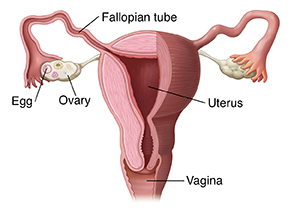Understanding Periods
Having a period is a normal, healthy part of becoming and being a woman. A period is the result of a cycle that takes place inside a woman's body. This menstrual cycle makes it possible for women to have babies. The cycle begins with the first day of bleeding. In the middle of the cycle, ovulation occurs. This is when an egg is released and begins its journey from the ovary to the uterus.
Gender words are used here to talk about anatomy and health risk. Please use this information in a way that works best for you and your provider as you talk about your care.

An egg is released
During each cycle, one egg grows and is released from an ovary. It finds its way to the fallopian tube. (If the egg and a man’s sperm meet, a woman may become pregnant.)
The egg travels through a tube
The egg moves through the fallopian tube toward the uterus.
The lining thickens
The lining of the uterus grows thicker. This lining is made up of blood, tissue, and fluid. (The lining will nourish a growing baby during pregnancy.)
The egg and lining are shed
About once a month, if pregnancy does not occur, the egg and the lining of the uterus are shed through the vagina. This is called a period. (A period does not happen during pregnancy.)